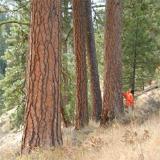 © Pete Saloutos/Panoramic Images (Washington Title Image Large)
© Pete Saloutos/Panoramic Images (Washington Title Image Large)

Blue Mountains Vegetation
Coniferous forests dominate much of the Blue Mountains. At higher elevations subalpine fir and Engelmann spruce are common. At mid-elevations Western larch, western white pine and lodgepole pine can be found, especially on slightly moister sites.
At mid-elevations Douglas-fir and ponderosa pine become prevalent. Open, park-like stands of ponderosa pine, with a snowberry and bunchgrass understory, host more vertebrate species than any other eastside forest.
Vegetation changes dramatically as hillsides plunge toward river bottoms along the Grande Ronde and Snake. In the higher canyons, shrublands can be found. Western juniper, snowberry, mountain mahogany, bitterbrush, and sage are among the shrubs found in the Blue Mountains.
At lower elevations grasslands are common. The famed Palouse prairie extends into the Blue Mountains, as do patches of shrub-steppe. Much of the grasslands and shrub-steppe have been displaced by agricultural operations.
Streamside areas covered in mountain alder, willows, and quaking aspen offer support for more wildlife species than any plant community type in the ecoregion. Of the Blue Mountains’ estimated 246 wildlife species, roughly a third are found in riparian wetland areas.
For details of this ecoregion within Washington, click a subheading in the left column.
View the more general description of this ecoregion in North America



